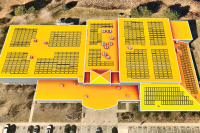Leaf-lookers’ primer
How did it get to be October already? Oh well, it’s here and the deep red sourwoods shinning from the road shoulder as we climbed up the Saluda grade on I-26 from one last weekend to the beach, plus pockets of color on distant mountain peaks, said it all – “it’s leaf season.” So, here is a little leaf-season primer.
Where does all that color come from? Well the yellows, orange and golds are produced by carotene (carotin) and xanthophylls. These pigments are present in the leaves already but are masked by the green chlorophyll produced during the growing season.
The red colors are produced a bit differently. The red comes from anthocyanin pigments. Anthocyanins are not present in the leaf during the growing season but are produced at the end of summer in the sap cells present in the leaf. The amount of anthocyanin (red) produced can depend on a lot of different things. One is the species of tree — sourwood, red maple, sugar maple and black gum are some of the trees noted for their red color. But even the genetics of a particular tree can play a large part. It’s not uncommon to see two red maples side by side — one brilliant red and one with splashes of red but lots of yellow. The red one is genetically predisposed to produce more anthocyanin.
And then there’s the weather. The perfect red scenario is bright sunny days — the sunshine aids the production of the sugars in the leaves that produce the anthocyanins — then cold autumn nights, below 45 degrees Fahrenheit, that inhibit the trees from translocating the sugars to the roots, trunk, etc essentially trapping them in the leaves.
While red and sugar maples often produce red fall foliage, striped or mountain maple generally produces golden-yellow. Other trees in the yellow group include birch, tulip poplar, the deciduous magnolias, beech and hickories.
Other factors that play a part in color production include the health and vigor of the particular tree and even the soil type. It’s easy to see how, with all these mitigating factors, each fall is a crapshoot when it comes to color. But weighing heavily in our favor here in Western North Carolina is the diversity, breath and scope of our Southern Appalachian forests. There are more tree species in the Great Smoky Mountains National Park alone than in the whole northern half of the European continent. The diversity of species, the myriad of habitats and the variation in local, microclimates, guarantees that there will be outstanding fall color somewhere, every fall. Of course, under optimal conditions it will be more widespread but as I have said in this column before, “… this October is going to be the best leaf season we’re going to have this year. And don’t be afraid to get out on those drizzly, overcast days.
Related Items
While we all revel in those bluebird autumn days when we can see multi-colored ridge after multi-colored ridge stretching to the horizon like a rumpled patchwork quilt, clouds and fog can produce their own striking effects.
(Don Hendershot is a writer and naturalist. He can be reached a This email address is being protected from spambots. You need JavaScript enabled to view it..)









